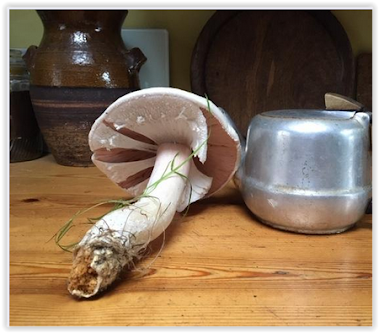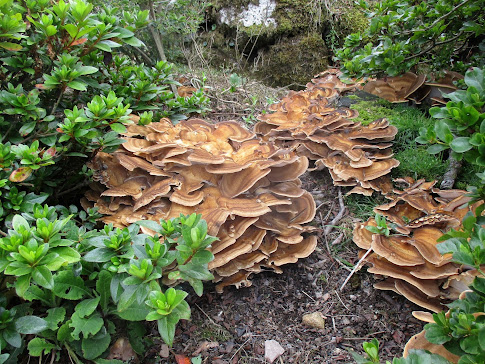Toadstools: Facilitators & Recyclers
 |
| Fly Agaric. This iconic toadstool appears in fairy stories and folklore throughout Europe. |
Fungi are neither nether plants nor animals. They comprise a huge entirely separate kingdom of organisms which have a universal, usually hidden, influence on our lives.
Toadstools and mushrooms are rather interchangeable words, although ‘Mushrooms’ infer ‘Edible’ and ‘Toadstools ‘suggest ’Poisonous’. They are both names for the visible fruiting or sporing stage of a fungus. They can vary from the size of a pin-head to as large as a dinner plate.
 |
| Horse Mushroom (and this wasn't the biggest!) |
or a colony may fill a wheelbarrow.....
 |
| Grifolia gigantea. This did fill a friend's wheelbarrow! |
There are over 15,000 species of fungi but many can be tricky
to identify and mistakes can be made; important when you are looking for edible
ones! Every year,headlines are
made when perhaps a whole family can be killed by eating one of the few deadly
poisonous species such as the Death Cap. This is most often on the continent where eating toadstools is
much more part of the culture, unlike us more conservative Brits.
 |
| Death Cap (Amanita phalloides) |
However, the very palatable Field Mushroom, Chantarelle and Cep or Penny Bun are highly sought-after in Britain too.
 |
| Chantarelles. |
 |
| Cep or Penny Bun (a Boletus) |
 |
| Field Mushroom |
The great majority of fungi are unpalatable rather than downright poisonous, but they can lead to upsets and a few species ARE DEADLY so be very cautious about foraging when you aren’t sure of your identification skills. Common misunderstandings are that edible mushrooms will peel easily, but so can some of the poisonous ones. And that the gills of an edible Field Mushroom are pink when young. Yes! But so are some of the poisonous ones!
Pictured below are a few examples of different types of sporing bodies of fungi.
 |
| Children delight in treading on Puffballs to send up a cloud of brown spores. |

The rather uncommon Clathrus rubrum.
 |
| A fungus resembling organ pipes appeared in the greenhouse last year. |
 |
| Orange-peel Fungus can appear in damp winter woodland. |
Fungi are largely saprophytic, that is they live off dead organic material, and break down the structure to get access to the mineral constituents. Some are parasitic and will kill the host, for example some forms of Honey Fungus, the dread of gardeners, and some Bracket Fungi.
 |
| Honey Fungus. This colony appeared on the roots of bushes up our lane for 30yards! |
 |
| Large Bracket Fungi on a dead Beech tree. Did they kill it? |
The visible part is but a fleeting appearance. The main part of a fungus is the Mycelium, the underground finely-branched root-equivalent which lives in the soil and may cover an extensive area. Some are claimed to be the largest single living individual organism on earth! The mycelium interacts closely with plant roots. This association is known as a Mycorrhizal Association and it is now realized that probably all plants have this partnership and indeed are unable to thrive without it.
The fine branches (Hyphae) of the mycelium make a huge surface area to absorb the products of the plant’s photosynthesis. The plant uses sunlight, water and carbon dioxide to produce sugars and oxygen, and the fungus takes some of this, and in turn produces minerals taken by the plant. Some fungi have hyphae which are closely bonded with the plant’s roots and in other cases actually penetrate the roots of for example, orchids.
(James Merryweather has written a very interesting article on this subject in the April 2020 issue of British Wildlife)
Fungi in other different groups within their kingdom are also very important in different spheres. These include the Yeasts, Rusts and Moulds. They have great medical significance, both as disease-causers such as Ringworm and other persistent skin disorders and lung disorders caused by a reaction to fungal spores. Rusts can decimate the yields of corn crops and of course Moulds are a source of Antibiotics.
A mould Cristulariella depraedans caused this spotting on Sycamore. The more familiar 'tar spot' on Sycamore leaves is also a mould.
Fungi also have a twofold importance in the food industry. Yeasts play a vital role in baking and brewing. Blue Moulds are used to make the distinctive varieties of Blue Cheeses. On the other hand they can cause spoilage on a big scale when foodstuffs are kept too long or stored in unsatisfactory conditions. Dry and wet rot in buildings are fungal and the often noxious treatment of roof timbers, telegraph poles, fence posts etc are measures taken to slow down decay.
The primary decay or breakdown of organic matter by fungi is followed by a great number of invertebrates which live off the decaying matter and thus recycle it further into the vital humus content of soils. But this aspect of the web of life is another story.
 |
| Fungi and invertebrates are breaking down this great trunk over the years.
|

Glad I caught up with this Mary, have posted it to LAPWG. Thank you. Jen B
ReplyDelete